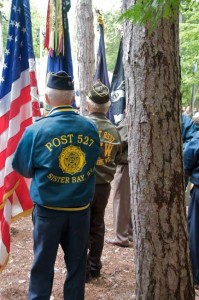Generation Gap
- Share
- Tweet
- Pin
- Share
When the Independence Day parade rolls through Baileys Harbor and Egg Harbor every 4th of July, a handful of aging veterans march in disciplined order, reminding us of the meaning behind the celebration.
When local schools strive to educate our youngest generation about the distant battles and fading memories of World War II, the Korean and Vietnam Wars, and the reality of armed conflict, members of the American Legion and Veterans of Foreign Wars share their first-hand accounts.

Members of American Legion Post 527 based in Sister Bay march in the Sister Bay Fall Fest Parade. Post members are worried because veterans are aging and membership declining. Photo by Dan Eggert.
And when a veteran is laid to rest in the Door County soil, a squad of his fellow veterans are there to perform a military burial, one final honor in exchange for the part of his life sacrificed in service of his country.
But the supply of veterans to fill these sometimes somber, sometimes celebratory roles is getting short. Those vets that are active in local American Legion and VFW posts are getting older, and they worry about the lack of younger veterans around and involved to replace them.
“I’m 69,” says Tom Kowalski, Commander of Billy Weiss American Legion Post 527 in Sister Bay, “and I’m one of the youngest guys at our meetings.”
Most of the post’s members are in their 70s, 80s, or 90s, Kowalski says regretfully. “That’s the problem,” he said. “I’m the Commander, and I can’t find anyone to replace me.”
Kowalski’s post claims 104 members, but he says only 20 – 25 of them are consistently active in post activities and fundraisers for veterans in need and scholarships. About a third of the post’s membership lives in Scandia Village retirement home.
Attendance at monthly meetings is growing increasingly sparse, and finding veterans to perform traditional services is a growing challenge.
“Widows of veterans call us and we have to scrounge together a squad to do a military funeral,” he says. “With more guys passing away it’s getting harder. It’s going to be tough to tell a veteran’s widow you can’t do it.”
Older vets like Kowalski want their younger cohorts to get involved, learn the ropes, and fill their roles, but Scott McFarlane said it’s hard to expect a young veteran to spend the time. McFarlane is Door County’s Veterans Services Officer and a Desert Storm veteran.
“Most of the guys that run the service organizations are retired and generally have the time to do it,” he said. “If you’re a young guy just out of the service, you want to get back to work, start a family, start a life. I can understand why they don’t get involved.”

An American Legion and VFW member participate in the ceremony marking Peninsula State Park’s 100th anniversary in June
Kowalski, who served six years in a stateside medical unit during the Vietnam War, acknowledges the point. He says he didn’t get involved himself until he moved to Door County nine years ago. He never gave much thought to joining a veteran’s organization until someone told him about the local American Legion Post.
There isn’t a very large pool of younger vets to draw from either. McFarlane estimates there are less than 20 veterans of the wars in Iraq and Afghanistan in Door County. Service members today have a much different experience than those of previous generations.
“In World War II,” McFarlane says, “you trained as a unit, served together, and came home together. You had all these guys who had experienced the same thing at the same time come back to the same community.”
Kowalski says that when World War II ended, 200 – 300 soldiers from this area came home together, and the veterans groups saw a massive influx of members, forming the backbone of the groups for generations. There was another bump after the Korean War, but McFarlane said circumstances created a missed opportunity for the American Legion and VFW after Vietnam.
“Vietnam vets were so mad when they got back because they didn’t feel they got the support of the older veterans when they felt the public turned on them,” McFarlane says. “So the American Legion and VFW lost that whole generation of vets that not only would have bolstered the group, but would have been a bridge to that younger generation. The young vets probably could have related better to them.”
Kowalski agrees that his fellow Vietnam veterans struggled to find a place in the groups.
“We didn’t feel like we fit with these guys, these older veterans were heroes,” he says. “Vietnam veterans shied away. The public made them feel unwelcome and so did a lot of the service organizations.”
Kowalski and his fellow veterans are working to make sure today’s veterans don’t feel the same lack of belonging. He said it’s more beneficial for younger veterans to get involved than older.
“There are many more programs available now for these guys than there were in the past,” he says. “You need to sign up now and get in the system, not wait till you’re an old guy like me and get put on the end of a three-year waiting list.”
Veterans are eligible for special loans, grant programs, housing assistance, and educational aid. The American Legion and VFW are important lobbyists for those programs and help make vets aware of what’s available to them.
“For some, the mindset is that they don’t want to take any welfare, but veterans benefits aren’t welfare,” Kowalski says. “Those benefits have been earned, they have this coming.”

